Aspirations—and current expectations—for IT have never been higher. Executives continue to set exacting demands for IT support of business processes, and they see an even larger role for IT in a competitive environment increasingly shaken up by technology disruptions. These are among the results of our sixth annual business technology survey, where we asked executives across all functions, industries, and regions about their companies’ use of, expectations for, and spending on IT.1 Looking ahead, executives expect IT to create new platforms to support innovation and growth, help guide strategy with data and advanced analytics, and stay on top of possible new roles for mobile devices. For IT leaders, the good news is that along with these higher expectations, most respondents also see a greater willingness to spend more on IT.
Meeting expectations
Among respondents to this survey, the highest current priorities for IT mirror those of previous surveys:2 improving the effectiveness and efficiency of business processes and reducing IT costs (Exhibit 1). Notably, 40 percent of respondents also indicate that providing managers with information to support planning and decision making is quickly becoming a critical priority, up from 30 percent just a year ago.
When asked what their organizations’ ideal priorities are, executives cite more growth-oriented goals. For example, creating new products and services is a priority for 47 percent of respondents. In contrast, only 17 percent cite reducing IT costs. Satisfaction with IT’s effectiveness is increasing among business executives, our data show. Greater numbers of non-IT executives report being very or extremely happy with IT performance across several measures, ranging from a high of 61 percent for providing basic services (such as e-mail and technical support for laptops and desktops) cost-effectively to a low of 26 percent for proactively engaging with business leaders on new ideas or system enhancements.
In parallel, the satisfaction of IT executives with their own ability to manage and deliver is trending upward as well. For example, 30 percent of IT executives report that their organizations are effective at driving technology enablement or innovation in business processes or operations, up 11 percentage points since last year. When asked what would further increase IT’s effectiveness, both IT and non-IT executives cite improving the talent and capabilities of IT staff (chosen by 53 percent), followed by improving accountability within the business for IT projects (chosen by 49 percent).
Focus on effectiveness and efficiency
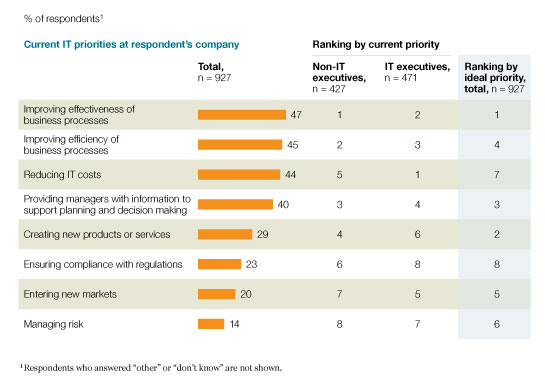
Higher budgets, changing priorities
Perhaps due to a combination of rising faith in IT, the realization of competitive challenges ahead, and a more positive business outlook, more respondents expect their organizations to increase spending in 2012 (Exhibit 2). Executives expect companies to increase their new investments in IT capabilities, with almost a quarter expecting to increase investments by more than 10 percent next year. And more than 60 percent expect to increase or maintain their IT operating expenses, a shift from last year when 60 percent of respondents expected the IT budget for operational spending to either decrease or hold steady.
We also asked where these expenditures are going. Respondents indicate that just over half of their current budgets go to infrastructure and core transactional applications. But when asked where they expect to be spending in three years, the balance shifts: those two areas shrink to 41 percent of the total, while end-user communications and collaboration, innovation, and analytics capabilities increase to 46 percent, from 35 percent currently.
Increasing IT budgets
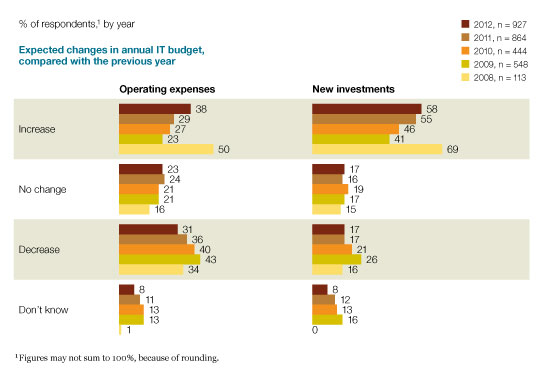
More data to support decisions
Executives say their companies still rely upon a mix of data and experience in decision making, although they are increasingly looking to analytics tools for support. In fact, respondents say their companies are shifting decision making to incorporate more data and analytics in almost all corporate functions, with the highest share (60 percent) citing marketing and sales as where this is likely to occur.3 For only one function—R&D—do fewer than half of respondents see a shift to using more data in decision making; 42 percent of them say so.
Most respondents say that managers and executives in their organizations are setting expectations for using data and analytic support in decision making. Indeed, one-third say all of their senior executives demand data, while almost two-thirds indicate that midlevel managers do the same.
Despite the promise of big data to reshape strategy and decision making,4 more than 75 percent of respondents to this survey report that their organizations’ greatest benefits from data use flow from clear and timely reporting of financial and performance metrics. Only about half say they seek to use data to provide new business insights or develop new information-based products and services.
We believe these simpler aspirations reflect the difficulties and barriers to more effective use of data and analytics in decision making. Respondents highlight three barriers in particular (Exhibit 3): a cultural preference for experience over data; a lack of skills in synthesizing and translating the analytics and data for decision makers; and concerns that the data quality is poor. All three of these barriers are recurrent themes in our discussions with clients.
Cultural and skill barriers
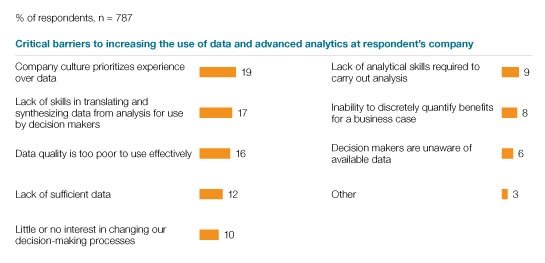
New platforms on the move
Both IT and non-IT executives say their organizations are beginning to take advantage of new platforms to further innovation: data and analytics, social Internet technologies (those known as Web 2.0), social media platforms (such as Facebook and Twitter), embedded computing, and cloud computing (Exhibit 4). Such platforms can be used to meet a variety of goals, including better customer and partner engagement and the creation of new products and services. While most respondents indicate that these platforms have yet to be deployed at scale, significant shares say their companies are using them in selected areas or piloting them.
Mobile technologies—for example, smartphones, tablets, and sensors—are growing in importance, according to respondents (Exhibit 5). They say their companies are using mobile technologies and applications both internally as collaboration and efficiency tools and externally to create stronger links with customers and business partners. Respondents in Europe are slightly ahead of the curve in mobile-technology deployment at scale. The region where these mobile technologies are most often deployed selectively in pockets across the enterprise is developed Asia:5 respondents there lead the rest of the world by anywhere from 10 to 20 percentage points in selective use of mobile for customer and business partner engagement.
Using new platforms
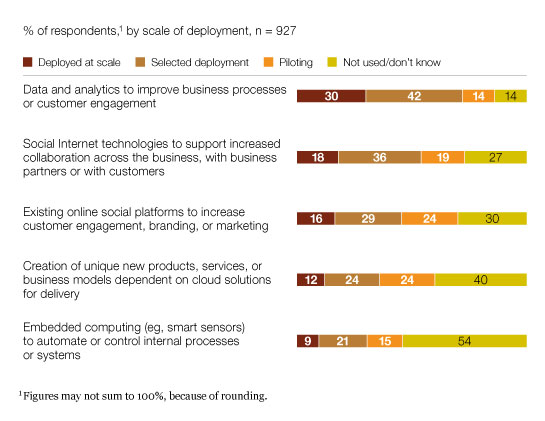
More internal deployment of mobile
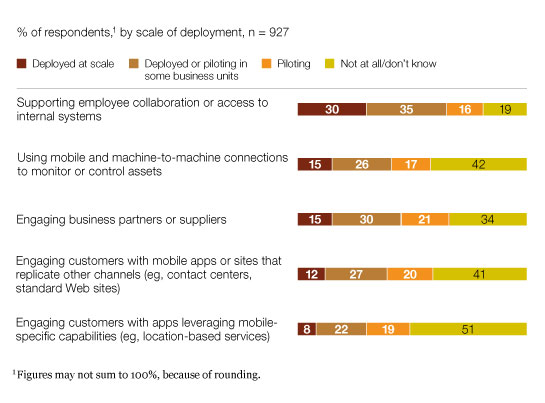
IT in the boardroom
As technology becomes a more important factor in reshaping industries, survey respondents say their organizations’ boards of directors should play a more active role in deciding how technology is incorporated into overall strategy (Exhibit 6). Respondents say that the most important technology-related discussions at their board meetings revolve around approval or review of very large IT projects; but ideally, they say, discussions should address forward-looking assessments of technology trends. We also asked executives how having a board member who is knowledgeable about technology and IT affects board discussions—many say it raises the level of discussion, but are unclear about any tangible results.
Misaligned board priorities
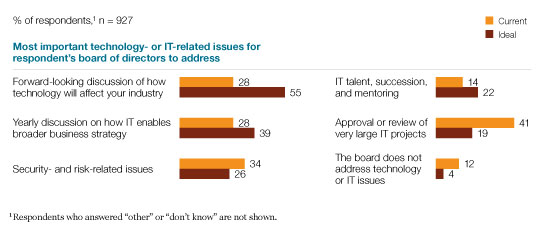
Looking ahead
Many executives indicate their companies are struggling with the substantial technical challenges of increasing their use of data and analytics. In our experience, some of the toughest challenges are creating a “single source” of truth, consolidating data architectures, and developing analytic tools and skills. But critical as these challenges are, successful rollouts often require a softer element—attention to the cultural changes to encourage increased reliance on data for decision making as well as the training required to help leaders at all levels incorporate analytics into regular practice.
According to respondents, business executives continue to ask IT to create more value by enabling business processes with technology, which is driving a significant amount of increased investment. In our experience, success in these efforts requires creating solid, well-defined business cases that include clear stage gates and metrics for holding business and IT leaders accountable.
New technology platforms and capabilities are clearly creating new opportunities at many different levels within organizations. We often see business executives experimenting with these platforms outside of IT’s awareness or permission. Given the proliferation and potential importance of these platforms, IT executives must shift from being gatekeepers to being enablers and service managers—guiding, supporting, and assisting their colleagues in these experiments to ensure that corporate policies, data security, or risk guidelines are not endangered.


